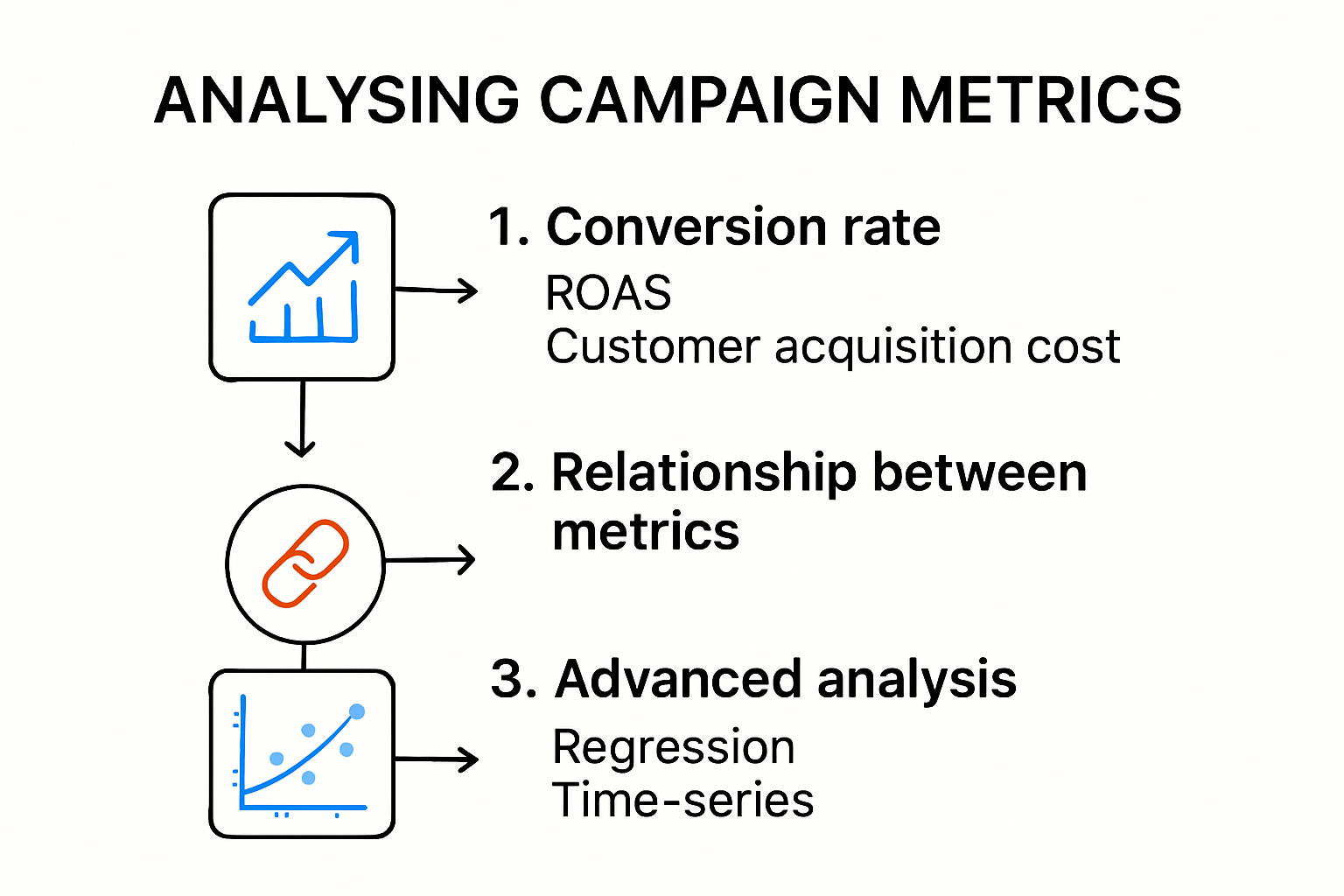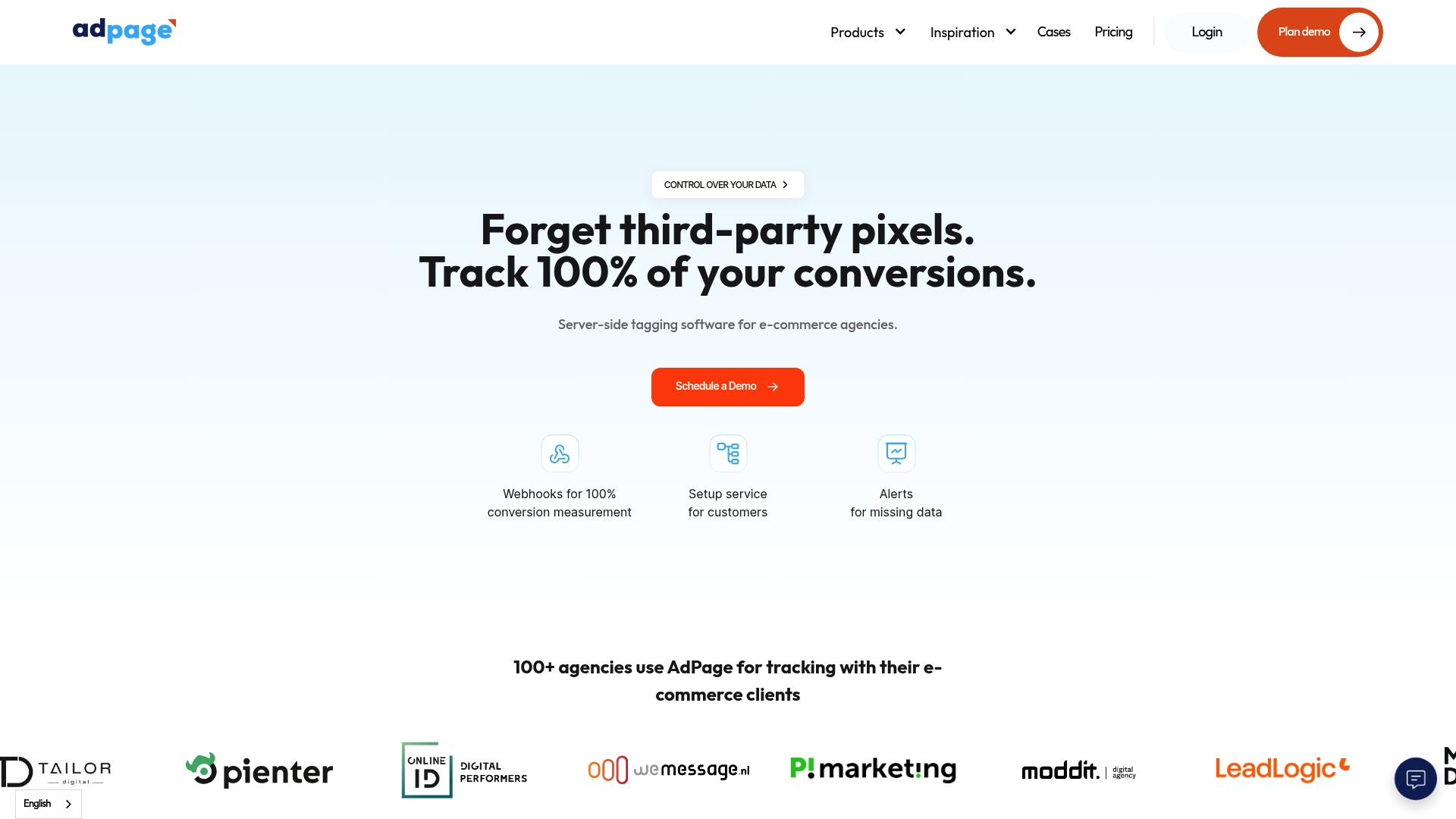Analyzing campaign performance is set to become the secret weapon for marketers looking to outsmart the competition in 2025. One surprising stat stands out. Brands that use predictive performance modeling can improve campaign outcomes by up to 35 percent compared to those relying only on traditional metrics. Yet most teams are still stuck tracking vanity figures that give a false sense of success. The real edge comes from digging deeper into advanced analytics and using insights that shape smarter, future-proof strategies.
Table of Contents
- Identifying The Right Campaign Metrics
- Effective Tools For Campaign Data Analysis
- Step-By-Step Process To Analyze Campaign Results.
- Optimising Campaigns Based On Analytics Insights
Quick Summary
| Takeaway | Explanation |
|---|---|
| Choose relevant campaign metrics | Focus on metrics that align with your specific marketing objectives to effectively measure performance. |
| Utilize advanced analytic tools | Implement sophisticated platforms for real-time data analysis and multi-channel integration to gain actionable insights. |
| Establish a structured evaluation process | Define clear objectives and select relevant metrics to create an effective framework for campaign analysis. |
| Apply predictive performance modeling | Use approaches like causal impact analysis to anticipate campaign outcomes and inform decision-making. |
| Embrace continuous learning | Cultivate a data-driven culture that encourages refinement of strategies based on ongoing campaign insights. |
Identifying the Right Campaign Metrics
Successful digital marketing hinges on selecting the most relevant performance metrics. Not all metrics carry equal weight, and businesses must strategically choose indicators that genuinely reflect campaign effectiveness and align with specific marketing objectives.
Understanding Core Performance Indicators
Choosing the right campaign metrics requires a nuanced approach. According to OpenStax's Principles of Marketing, cost per thousand impressions (CPM) serves as a fundamental metric for understanding advertisement visibility and reach. However, modern marketing demands a more comprehensive evaluation strategy.
Key Performance Indicators that warrant close examination include:
- Conversion Rate: Measures the percentage of users who complete a desired action
- Return on Ad Spend (ROAS): Calculates the revenue generated per marketing pound invested
- Customer Acquisition Cost: Tracks the total expense of securing a new customer
These metrics provide actionable insights into campaign performance beyond surface-level engagement numbers. Marketers must move beyond vanity metrics that look impressive but offer minimal strategic value.
Advanced Metric Analysis Techniques
Advanced campaign performance analysis requires sophisticated approach. Research exploring campaign dynamics suggests implementing statistical models to identify change points and trends in marketing performance. This approach enables marketers to detect subtle shifts in campaign effectiveness that traditional metrics might overlook.
Complex performance tracking involves understanding interdependent metrics. For instance, a high click-through rate means little if those clicks do not translate into meaningful conversions. Businesses must develop a holistic view that connects various performance indicators.
Statistical techniques like regression analysis and time-series modeling can help uncover hidden correlations between different marketing metrics. These advanced methods provide deeper insights than standalone performance measurements.

Implementing a Data-Driven Approach
Successful metric identification requires a strategic framework. Marketers should:
- Align metrics with specific business objectives
- Establish clear benchmarks for performance
- Continuously refine measurement strategies
This systematic approach ensures that campaign tracking evolves alongside business goals. By treating metrics as dynamic tools rather than static indicators, organizations can adapt their marketing strategies more effectively.
Ultimately, identifying the right campaign metrics is not about collecting data but extracting meaningful insights. Businesses must cultivate a culture of continuous learning and strategic adaptation, using performance metrics as a compass for future marketing innovations.
Effective Tools for Campaign Data Analysis
Digital marketing professionals require robust analytical tools to transform raw campaign data into actionable insights. Modern data analysis goes beyond simple reporting, demanding sophisticated platforms that can process complex information and generate meaningful strategic recommendations.
Comprehensive Analytics Platforms
Choosing the right data analysis tool is critical for understanding campaign performance. According to the Institute of Education Sciences Program Evaluation Toolkit, effective data analysis requires systematic preparation and interpretation techniques. Contemporary marketing teams need platforms that offer more than basic metric tracking.
Key features of effective campaign analysis tools include:
- Real-time Data Processing: Ability to analyze data instantaneously
- Multi-channel Integration: Consolidating insights from various marketing channels
- Advanced Visualization: Transforming complex data into understandable graphics
These capabilities enable marketers to move beyond retrospective analysis and develop predictive strategies that anticipate market trends.
Advanced Analytical Methodologies
Beyond traditional tools, marketing professionals are increasingly adopting sophisticated analytical approaches. PATH's Evaluation Resources highlight the importance of systematic root cause analysis in understanding campaign performance.
Statistical techniques such as regression analysis, machine learning algorithms, and predictive modeling can uncover hidden patterns in campaign data. These advanced methodologies provide deeper insights than conventional reporting, allowing businesses to understand not just what happened, but why it occurred and how to improve future strategies.
Implementing Data Analysis Strategies
Successful data analysis requires more than powerful tools. Organizations must develop a strategic approach to tracking digital marketing performance. This involves creating a structured framework for data collection, interpretation, and action.
Key steps in implementing effective data analysis include:
- Establish clear analytical objectives
- Select appropriate tools and technologies
- Train team members in advanced analytical techniques
- Create standardized reporting mechanisms
- Continuously refine analytical approaches
By adopting a holistic approach to campaign data analysis, businesses can transform raw information into strategic intelligence. The goal is not merely to collect data, but to generate insights that drive meaningful marketing decisions and improve overall campaign performance.
Ultimately, effective tools for campaign data analysis are about empowering marketing teams to make informed, data-driven decisions that deliver tangible business results.
To clarify the main features to look for in an analytics platform, the table below organizes the key capabilities discussed above:
| Feature | Description | Benefit |
|---|---|---|
| Real-time Data Processing | Analyzes data instantaneously | Immediate insights for quick actions |
| Multi-channel Integration | Consolidates insights from multiple sources | Unified view of performance |
| Advanced Visualization | Presents complex data as understandable graphics | Easier interpretation of metrics |
Step-by-Step Process to Analyze Campaign Results.
Analyzing campaign results requires a structured and systematic approach that transforms raw data into meaningful strategic insights. Successful marketing teams develop a comprehensive methodology that goes beyond surface-level metrics to uncover deeper performance implications.
Establishing Evaluation Framework.
According to the Centers for Disease Control and Prevention, effective campaign evaluation demands a clear, phased approach to data collection. This involves establishing precise evaluation metrics aligned with specific campaign objectives.
Key foundational steps include:
- Define Clear Objectives: Articulate specific, measurable campaign goals
- Select Relevant Metrics: Choose indicators directly tied to campaign outcomes
- Create Baseline Measurements: Establish benchmarks for performance comparison
Marketing professionals must move beyond generic tracking, developing a nuanced understanding of how individual metrics interconnect and influence overall campaign performance.
Comprehensive Data Collection Techniques
Higher Education Marketing emphasizes the importance of gathering multifaceted feedback. This approach involves collecting both quantitative and qualitative data to provide a holistic view of campaign effectiveness.
Data collection should incorporate multiple sources:
- Digital analytics platforms
- Customer surveys and feedback
- Stakeholder interviews
- Comparative performance benchmarks
By integrating diverse data points, organizations can develop a more comprehensive understanding of campaign dynamics. Tracking digital marketing performance requires a sophisticated approach that goes beyond traditional reporting.
Advanced Analysis and Reporting
According to Symanto, effective campaign analysis involves interpreting both structured numerical data and qualitative insights. Key performance indicators should illuminate not just surface-level metrics, but underlying trends and potential strategic opportunities.
Reporting should follow a structured approach:
- Summarize key performance metrics
- Highlight unexpected insights
- Provide actionable recommendations
- Compare results against initial objectives
Successful campaign analysis is not about presenting data, but translating complex information into clear, strategic guidance. Marketing teams must develop the capability to transform raw numbers into compelling narratives that drive future decision-making.
Ultimately, the step-by-step process of analyzing campaign results is an iterative journey. Each analysis provides valuable learning opportunities, enabling continuous improvement and more sophisticated marketing strategies. By adopting a systematic, data-driven approach, organizations can turn campaign performance metrics into a powerful tool for strategic growth.
The following table summarizes the step-by-step process for campaign analysis described in this section. This will help you visualize and implement each stage effectively:
| Step | Purpose | Example Action |
|---|---|---|
| Define Clear Objectives | Set specific, measurable goals for the campaign | Increase sign-ups by 20% |
| Select Relevant Metrics | Choose indicators that align with objectives | Track conversion rate |
| Create Baseline Measurements | Establish starting benchmarks for comparison | Document current sign-up rate |
| Gather Data from Multiple Sources | Collect quantitative & qualitative feedback | Use analytics, surveys, interviews |
| Summarise & Report Findings | Interpret data and highlight insights | Create comparison reports |
| Recommend Strategic Actions. | Translate findings into actionable steps | Suggest optimization opportunities |
Optimizing Campaigns Based on Analytics Insights
Transforming raw campaign data into actionable strategies requires a sophisticated approach to analytics-driven optimization. Modern marketing professionals must leverage advanced analytical techniques to continuously refine and improve campaign performance.
Predictive Performance Modeling
Cutting-edge research introduces innovative approaches to campaign optimization. The Predictive Incrementality by Experimentation (PIE) model represents a breakthrough in understanding campaign effectiveness, utilizing randomized controlled trials to predict the causal effects of advertising initiatives.
Key optimization strategies include:
- Causal Impact Analysis: Identifying true campaign drivers
- Incremental Conversion Tracking: Measuring precise economic impact
- Predictive Performance Forecasting: Anticipating potential campaign outcomes.
This approach moves beyond traditional retrospective analysis, enabling marketers to make proactive, data-driven decisions that maximize campaign potential.
Advanced Visualization and Simulation
PromotionLens, a sophisticated visual analytics system, demonstrates the power of advanced campaign optimization techniques. By integrating multivariate time-series forecasting with interactive visualizations, marketers can conduct comprehensive 'what-if' analyses that reveal hidden performance opportunities.
Effective optimization requires a multi-dimensional approach:
- Develop comprehensive performance models
- Create detailed scenario simulations
- Implement iterative refinement strategies
- Continuously validate analytical insights
The goal is to transform campaign data from historical reporting to predictive intelligence. Optimising ad spend becomes a strategic process of continuous learning and adaptation.
Feature Engineering and Predictive Analytics
Cutting-edge research highlights the critical importance of sophisticated feature engineering in ad performance prediction. According to advanced machine learning studies, precise feature selection and engineering can dramatically improve prediction accuracy for critical metrics like clicks and conversions.
Successful campaign optimization requires:
- Sophisticated data preprocessing
- Advanced machine learning techniques
- Continuous model refinement
- Holistic performance interpretation
Marketers must move beyond traditional metrics, developing a nuanced understanding of complex performance indicators. The most successful campaigns leverage analytics not as a reporting tool, but as a strategic decision-making framework.
Ultimately, optimizing campaigns based on analytics insights is an ongoing journey of discovery. By embracing advanced analytical techniques, marketing teams can transform data into a powerful competitive advantage, continuously improving campaign performance and driving meaningful business results.

Frequently Asked Questions
What metrics should I focus on when analyzing campaign performance?
To effectively analyze campaign performance, focus on metrics that align with your marketing objectives, such as conversion rate, return on ad spend (ROAS), and customer acquisition cost. These metrics provide deeper insights into the effectiveness of your campaigns.
How can advanced analytical tools improve campaign analysis?
Advanced analytical tools enable real-time data processing, multi-channel integration, and enhanced visualization. These features help marketers gain actionable insights and develop predictive strategies that can lead to better campaign outcomes.
What is predictive performance modeling and how does it help?
Predictive performance modeling uses statistical techniques to forecast potential campaign outcomes by analyzing historical data. It helps marketers anticipate the effectiveness of strategies, enabling more informed decision-making and optimization.
How can I establish a structured evaluation framework for my campaigns?
To establish a structured evaluation framework, define clear campaign objectives, select relevant metrics, and create baseline measurements for performance comparison. This systematic approach ensures you track progress effectively and adapt strategies as needed.
Supercharge Your Campaign Analysis With Reliable Conversion Tracking
Stuck analyzing campaign data that leaves you guessing about the true impact of your marketing investments? As outlined in this article, many teams feel the frustration of vanity metrics, data loss and incomplete analytics. You need consistent performance indicators, not numbers that disappear due to browser restrictions or unreliable tracking. Imagine what you could achieve if you had 100 per cent visibility into every conversion, enabling you to unlock advanced metrics, predictive performance modeling and true optimization potential.

Take control of your campaign results starting now. AdPage empowers marketers and agencies with server-side tagging, seamless e-commerce integrations, and consent management to ensure data accuracy and compliance. Say goodbye to missed conversions and take advantage of robust reporting tools that directly support the strategies outlined in this article. Visit AdPage's main site to see how you can future-proof your analytics and achieve smarter, data-driven growth today.
Recommended
-
[
Types of Digital Advertising: A 2025 Guide for Colorado Businesses
](https://peakdigital.pro/2025/06/25/types-of-digital-advertising-colorado-2025)
-
A/B Test Result Reporting: How to Analyze and Present Data (2025)



.png)
